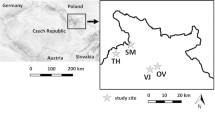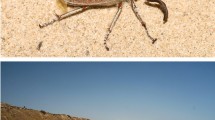Abstract
Corridors are often considered to promote dispersal between habitat patches. In this paper, we study whether or not corridors induce colonisation of nunataks (ice-free areas in glacier surroundings) by promoting dispersal from lowland to the nunataks. On outlet glaciers, debris originating from nunataks forms the so-called medial moraines that stretch from the nunataks down-glacier to the lowland, forming corridors of debris on the glacier. Aerial dispersal was determined with yellow sticky traps on the moraines, bare glacier and glacier foreland. Dipterans were sampled in pitfall traps on the nunataks. Flying insects that were present on the vegetated glacier foreland belonged to five orders, that is, Diptera, Hemiptera, Hymenoptera, Lepidoptera and Trichoptera. On the glacier and medial moraines, however, mainly dipterans were present, with the majority of individuals found on the moraines. Hoverflies (Syrphidae) were abundant on the moraines and on the edges of nunataks close to the moraines, but were not present on the vegetated foreland. The origin of the hoverflies is thus not the nunataks and not the lowland. Rather, they are brought in by air currents towards the glacier, where they aggregate on a land type where they have a chance of survival, although it is not habitable. Thus, we conclude that the medial moraines do not function as regular corridors but as drift fences that direct the dispersal towards the adjacent land types, that is, the nunataks and the glacier foreland.




Similar content being viewed by others
References
Anderson RS (2000) A model of ablation-dominated medial moraines and the generation of debris-mantled glacier snouts. J Glaciol 46:459–469
Armitage PD (1995) Behaviour and ecology of adults. In: Armitage PD, Cranston PS, Pinder LCV (eds) The chironomidae: the biology and ecology of non-biting midges. Chapman & Hall, London, pp 194–224
Barry RG (2006) The status of research on glaciers and global glacier recession: a review. Prog Phys Geogr 30:285–306
Bartsch H (2009) Nationalnyckeln till Sveriges flora och fauna. Diptera: Syrphidae: Syrphinae. Artdatabanken, Uppsala
Baum KA, Haynes KJ, Dillemuth FP, Cronin JT (2004) The matrix enhances the effectiveness of corridors and stepping stones. Ecology 85:2671–2676
Berggren A, Birath B, Kindvall O (2001) Effect of corridors and habitat edges on dispersal behavior, movement rates and movement angles in Roesel’s bush-cricket metrioptera roeseli. Conserv Biol 16:1562–1569
Birks HJB (1980) The present flora and vegetation of the moraines of the Klutlan glacier, Yukon territory, Canada—a study in plant succession. Quatern Res 14:60–86
Björnsson S (1958) Könnunarferð í Kárasker. Jokull 8:15–17
Björnsson H (2009) Jöklar á Íslandi. Opna, Reykjavík
Coulson SJ, Midgley NG (2012) The role of glacier mice in the invertebrate colonisation of glacial surfaces: the moss balls of the Falljökull, Iceland. Polar Biol. doi:10.1007/s00300-012-1205-4
Coulson SJ, Hodkinson ID, Webb NR, Mikkola K, Harrison JA, Pedgley DE (2002) Aerial colonization of high Arctic islands by invertebrates: the diamondback moth Plutella xylostella (Lepidoptera: Yponomeutidae) as a potential indicator species. Divers Distrib 8:327–334
Coulson SJ, Hodkinson ID, Webb NR (2003) Aerial dispersal of invertebrates over a high-arctic glacier foreland: midtre Lovenbreen, Svalbard. Polar Biol 26:530–537
Drake VA, Farrow RA (1988) The influence of atmospheric structure and motions on insect migration. Annu Rev Entomol 33:183–210
Einarsson E (1998) Ung og gömul jökulsker í Breiðamerkurjökli. Landnám og framvinda gróðurs. In: Árnason GS, Arnarson BG, Jörundsson EP, Svavarsdóttir G, Torfason Z (eds) Kvískerjabók. Höfn, Sýslusafn Austur-Skaftafellssýslu, pp 222–254
Elton CS (1925) The dispersal of insects to Spitsbergen. Trans Entomol Soc Lond 73:289–299
Fickert T, Friend D, Gruninger F, Molnia B, Richter M (2007) Did debris-covered glaciers serve as pleistocene refugia for plants? A new hypothesis derived from observations of recent plant growth on glacier surfaces. Arct Antarct Alp Res 39:245–257
Gilbert-Norton L, Wilson R, Stevens JR, Beard KH (2010) A meta-analytic review of corridor effectiveness. Conserv Biol 24:660–668
Gobbi M, Isaia M, De Bernardi F (2011) Arthropod colonisation of a debris-covered glacier. Holocene 21:343–349
Gustafsson L, Hansson L (1997) Corridors as a conservation tool. Ecol Bull 46:182–190
Haddad NM, Baum KA (1999) An experimental test of corridor effects on butterfly densities. Ecol Appl 9:623–633
Hodson A et al (2008) Glacial ecosystems. Ecol Monogr 78:41–67
Ingimarsdóttir M, Ripa J, Magnúsdóttir ÓB, Hedlund K (2013) Food web assembly in isolated habitats: a study from recently emerged nunataks, Iceland. Basic Appl Ecol 14:174–183
Jensen J-K (2009) Fund af nye og sjældne svirrefluer på Færøerne (2000–2008) (Diptera: Syrphidae). Entomol Medd 77:3–7
Johnson CG (1969) Migration and dispersal of insects by flight. Methuen, London
Kuefler D, Hudgens B, Haddad NM, Morris WF, Thurgate N (2010) The conflicting role of matrix habitats as conduits and barriers for dispersal. Ecology 91:944–950
Leibold MA et al (2004) The metacommunity concept: a framework for multi-scale community ecology. Ecol Lett 7:601–613
MacArthur RH, Wilson EO (1967) The theory of island biogeography. Princeton University Press, New Jersey
Magnússon B, Magnússon SH (2000) Vegetation succession on Surtsey, Iceland, during 1990–1998 under the influence of breeding gulls. Surtsey Res 11:9–20
McLaughlin JF, Hellmann JJ, Boggs CL, Ehrlich PR (2002) Climate change hastens population extinctions. Proc Natl Acad Sci USA 99:6070–6074
Öckinger E, Smith HG (2008) Do corridors promote dispersal in grassland butterflies and other insects? Landsc Ecol 23:27–40
Oerlemans J et al (1999) Glacio-meteorological investigations on Vatnajokull, Iceland, summer 1996: an overview. Bound-Layer Meteorol 92:3–26
Pryke SR, Samways MJ (2001) Width of grassland linkages for the conservation of butterflies in South African afforested areas. Biol Conserv 101:85–96
Ricketts TH (2001) The matrix matters: effective isolation in fragmented landscapes. Am Nat 158:87–99
Rosenberg DK, Noon BR, Megahan JW, Meslow EC (1998) Compensatory behavior of ensatina eschscholtzii in biological corridors: a field experiment. Can J Zool 76:117–133
Schaefer GW (1976) Radar observations of insect flight. In: Rainey RC (ed) Royal entomological society syposium 7: insect flight, vol 7. Blackwell Scientific Publications, Oxford, pp 157–197
Simberloff D, Farr JA, Cox J, Mehlman DW (1992) Movementcorridors—conservation bargains or poor investments. Conserv Biol 6:493–504
Svensson BG, Janzon LA (1984) Why does the hoverfly metasyrphus corollae migrate? Ecol Entomol 9:329–335
ter Braak CJF, Šmilauer P (2002) CANOCO reference manual and CanoDraw for windows user’s guide: software for canonical community ordination (version 4.5). Microcomputer power, Ithaca, New York
Tewksbury JJ et al (2002) Corridors affect plants, animals, and their interactions in fragmented landscapes. Proc Natl Acad Sci USA 99:12923–12926
Thornton IWB et al (2002) How important were stepping stones in the colonization of krakatau? Biol J Linn Soc 77:275–317
Acknowledgments
The study was performed in Vatnajökull National Park. All the people who gave advices on the nunataks and the glacier, lent us and transported equipment/supplies are thanked, especially Hálfdán and Helgi Björnsson farmers at Kvísker, Öræfi. Ólöf Birna Magnúsdóttir and Tancredi Caruso assisted in the field. Bjarni D. Sigurðsson and Starri Heiðmarsson operated the weather station. Erling Ólafsson identified the hoverflies. Anette Meier made the map of study sites. The work was supported by Kvískerjasjóður and Kungliga Fysiografiska Sällskapet i Lund.
Author information
Authors and Affiliations
Corresponding author
Rights and permissions
About this article
Cite this article
Ingimarsdóttir, M., Ripa, J. & Hedlund, K. Corridor or drift fence? The role of medial moraines for fly dispersal over glacier. Polar Biol 36, 925–932 (2013). https://doi.org/10.1007/s00300-013-1316-6
Received:
Revised:
Accepted:
Published:
Issue Date:
DOI: https://doi.org/10.1007/s00300-013-1316-6




